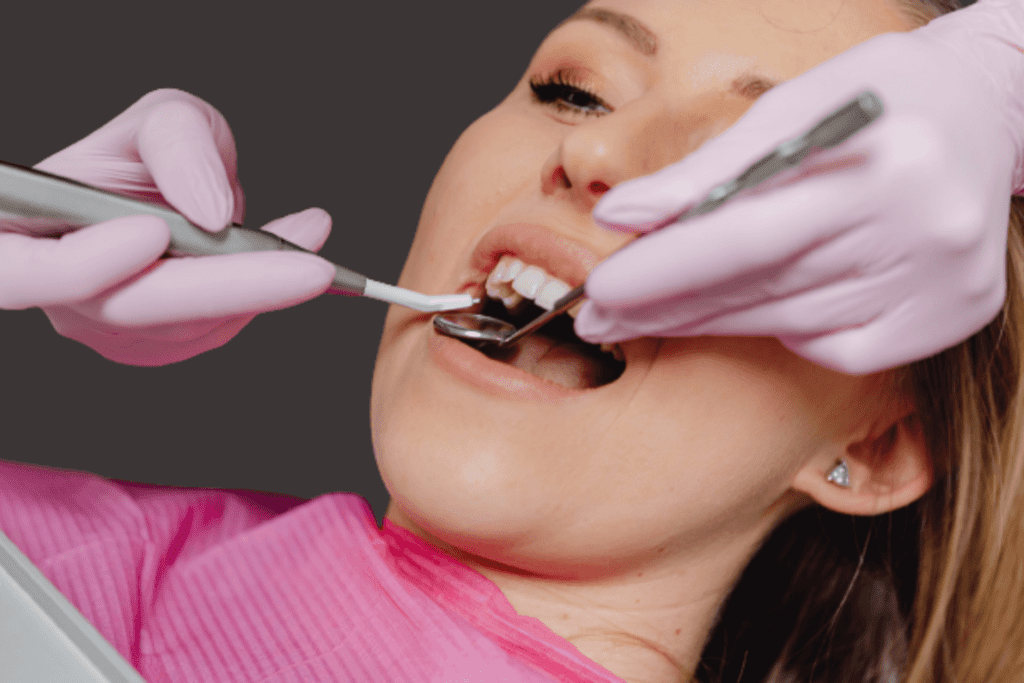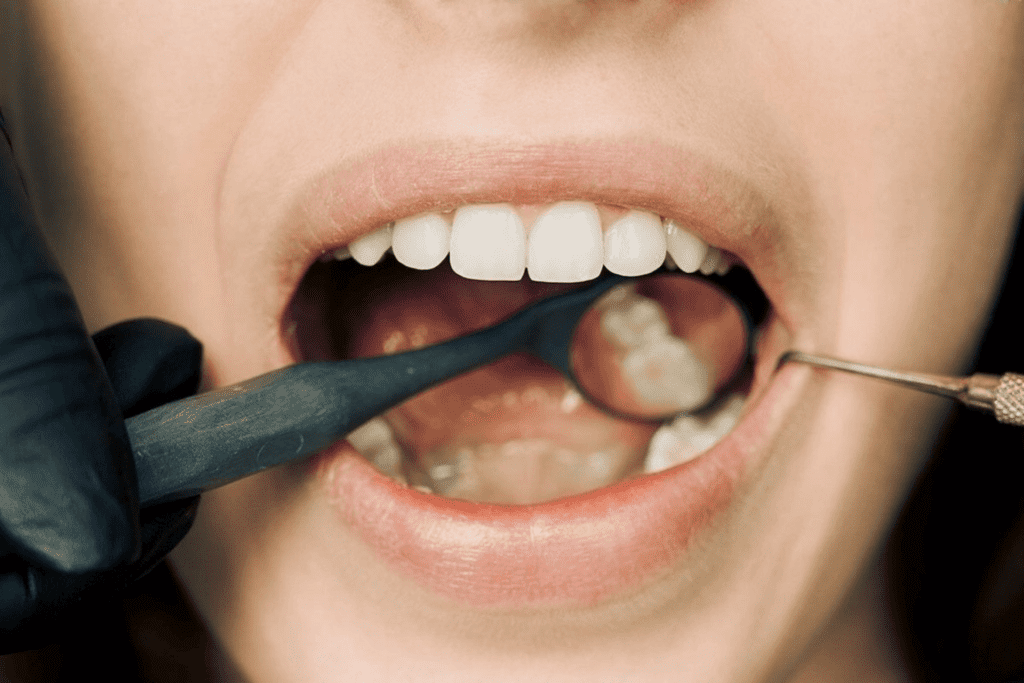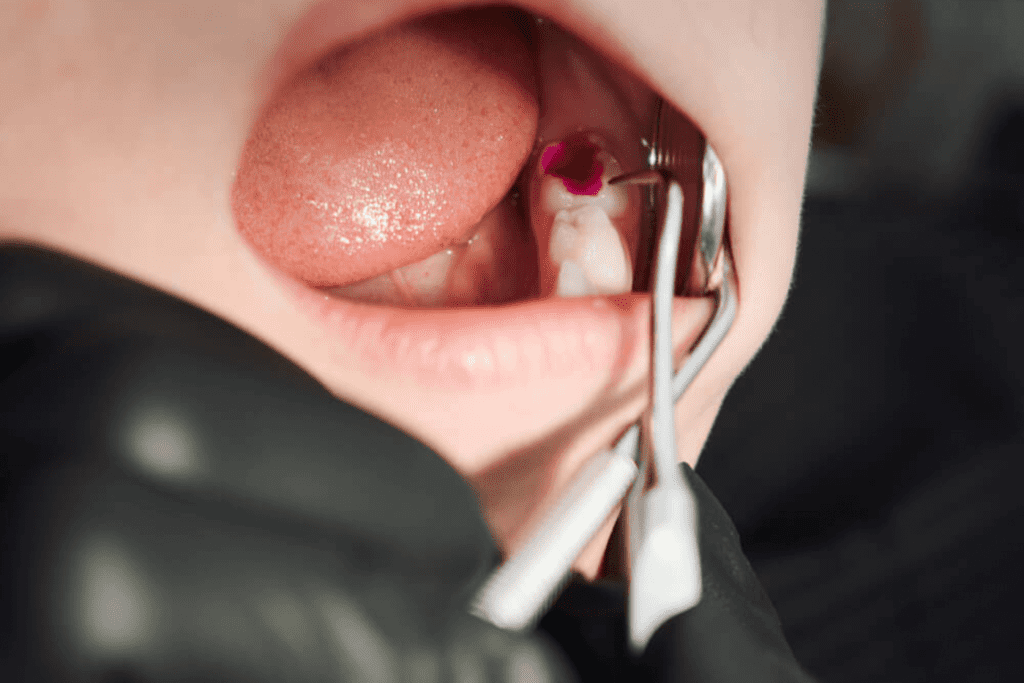We sometimes add products that we believe may be beneficial to our readers. We may receive a small commission if you purchase using the links on this page. Read our affiliate disclaimer
What is Teeth Whitening? Teeth whitening is a procedure designed to brighten the shade of teeth and eliminate any staining or discoloration. It involves the use of various techniques and products to brighten the appearance of teeth, making them appear whiter and brighter. Teeth whitening methods can range from do-it-yourself options like whitening toothpaste or strips to professional treatments performed by dentists. These methods typically involve the application of bleaching agents, such as hydrogen peroxide or carbamide peroxide, which break down stains and lighten the tooth color. Teeth whitening can help improve the aesthetic appeal of teeth and enhance one’s smile.
Table of Contents
ToggleTypes of Teeth Whitening Methods
There are various types of teeth whitening methods available, ranging from professional treatments performed by dentists to at-home options.
Here are some common types of teeth whitening methods:
1. In-Office Teeth Whitening (Professional Teeth Whitening)
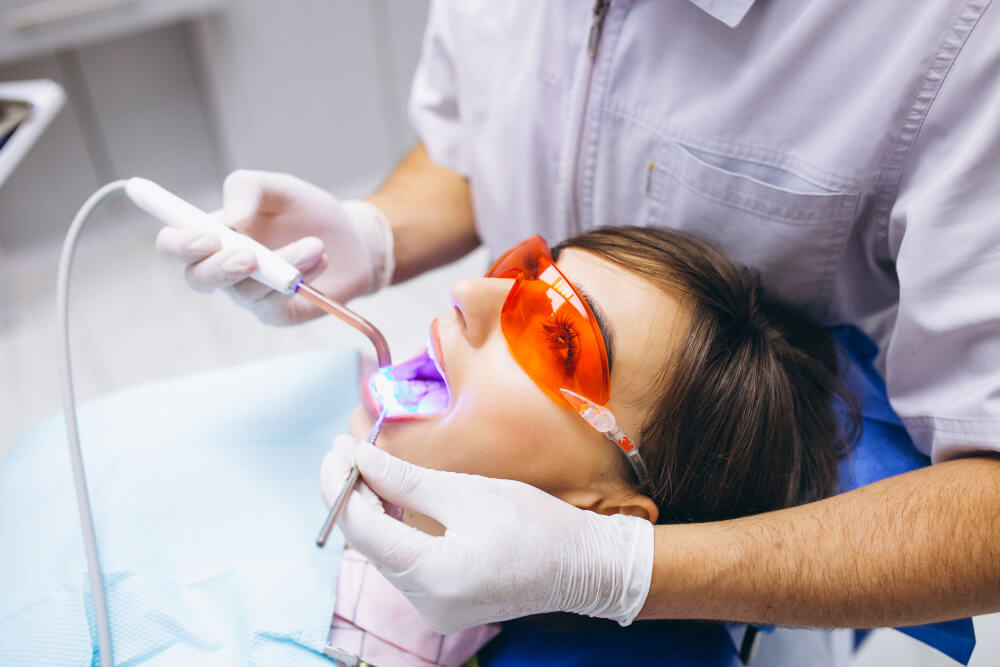
This is a professional teeth whitening treatment performed by dentists in a dental office or clinic. It typically involves the application of a high-concentration bleaching gel to the teeth, which may be activated by a special light or laser. In-office whitening can provide faster and more noticeable results compared to at-home methods.
Types of In-Office Teeth Whitening Methods
There are several types of in-office teeth whitening methods that dentists may offer. These methods differ in terms of the whitening agents used, activation techniques, and treatment duration.
There exist several widely used methods for teeth whitening performed in dental offices. These methods include:
Light-Activated or Laser Teeth Whitening:
This method involves the application of a high-concentration whitening gel to the teeth, followed by the use of a specialized light or laser to activate the gel and enhance the whitening process. The light or laser helps to accelerate the chemical reaction of the whitening agent, leading to faster results.
Non-Light or Chemically Activated Teeth Whitening:
In this method, a high-concentration whitening gel is applied to the teeth without the use of any external light or laser activation. The gel contains a chemical agent, such as hydrogen peroxide or carbamide peroxide, which initiates the whitening process on its own. The treatment duration is typically longer compared to light-activated methods.
Chairside Whitening with a Whitening Lamp:
Some dentists may use a whitening lamp, which emits a specific wavelength of light, to accelerate the teeth whitening process. The whitening gel is applied to the teeth, and the whitening lamp is positioned to shine the light onto the gel-coated teeth. The combination of the gel and the light helps achieve faster and more noticeable results.
Power Bleaching:
Power bleaching is a technique that involves the application of a highly concentrated bleaching gel to the teeth, which is typically activated using a light or laser. This method is often recommended for individuals with significant tooth discoloration or stubborn stains. It can deliver impressive results in a relatively shorter treatment time.
Customized Tray-Based Whitening:
This method involves the fabrication of custom-made trays that precisely fit your teeth. The dentist takes impressions of your teeth to create these trays, which are filled with a professional-strength whitening gel. You are provided with the trays and instructions to wear them at home for a specified duration each day. The duration of the treatment can vary based on the desired extent of teeth whitening.
Combined or Hybrid Whitening:
Some dentists may offer a combination of in-office and at-home whitening methods. This approach involves an initial in-office treatment to jump-start the whitening process, followed by the use of customized trays and a whitening gel provided for at-home use to maintain and enhance the results.
The Procedure of In-Office Teeth Whitening
The procedure for in-office teeth whitening may vary depending on the specific method used by the dentist. However, here is a general outline of the steps involved in an in-office teeth whitening treatment:
Consultation:
The process typically begins with a consultation where you discuss your goals, oral health history, and any concerns with the dentist. The dental professionals will evaluate the current color of your teeth and determine your eligibility for teeth whitening.
Preparing the Mouth:
Before the whitening treatment, the dentist may clean your teeth to remove any plaque or debris. They may also place a dental dam or protective barrier to shield your gums and soft tissues from the whitening gel.
Applying the Whitening Gel:
The dentist will apply a professional-strength whitening gel to your teeth. The gel contains a bleaching agent, usually hydrogen peroxide or carbamide peroxide, which breaks down stains and discoloration on the tooth surface.
Activating the Gel (optional):
Depending on the method used, the dentist may activate the whitening gel with a specialized light, laser, or heat source. This activation can help accelerate the whitening process and enhance the effectiveness of the gel.
Waiting Period:
After the gel is applied, you will typically wait for a designated period, usually around 15-30 minutes, while the whitening agents work on your teeth. During this time, you may relax in the dental chair or engage in other activities to pass the time
Rinse and Evaluation:
After the waiting period, the dentist will rinse off the whitening gel from your teeth and evaluate the initial results. They may compare the before and after shades of your teeth to assess the level of whitening achieved.
Additional Sessions (if needed):
Depending on the desired level of whitening and the initial results, the dentist may recommend additional whitening sessions. This can involve repeating the process or providing customized take-home whitening trays for maintenance and touch-ups.
Post-Treatment Instructions:
The dentist will provide you with post-treatment instructions to optimize the results and minimize sensitivity. This may include avoiding certain foods and beverages that can stain the teeth and following proper oral hygiene practices.
What Stains Removed In-Office Teeth Whitening?
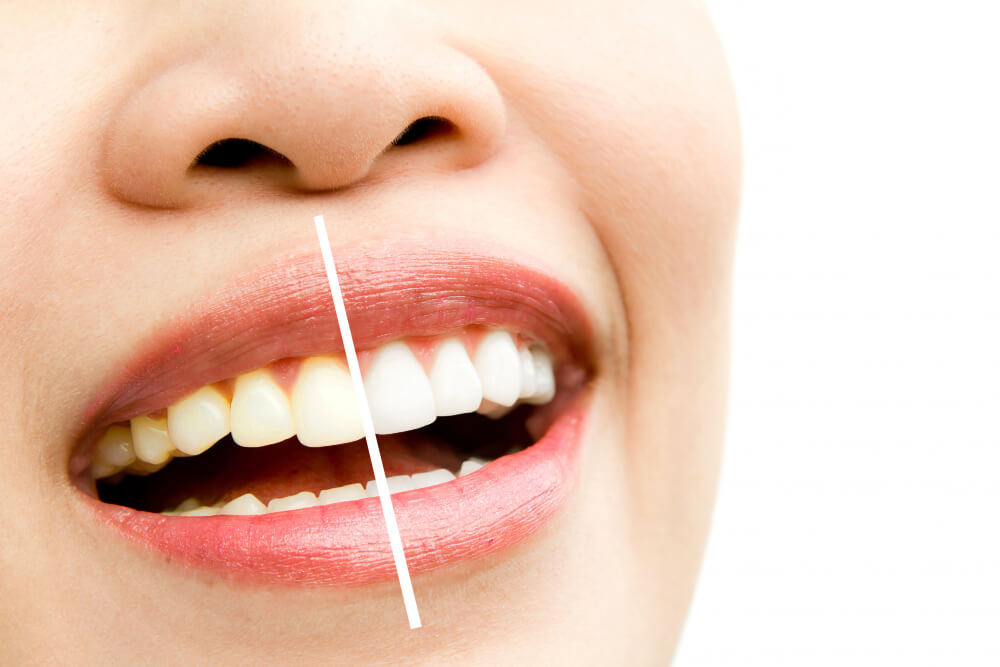
In-office teeth whitening is effective at removing certain types of stains from the teeth. The specific stains that can be successfully treated may depend on the method used and the individual’s unique circumstances.
Here are a few typical categories of stains that can be effectively treated using in-office teeth whitening techniques:
Extrinsic Stains:
These stains are superficial and develop on the outermost layer of the tooth, known as the enamel. Extrinsic stains are often caused by factors such as the consumption of coffee, tea, red wine, tobacco use, or certain foods. In-office teeth whitening can effectively target and remove these extrinsic stains, resulting in a brighter and whiter smile.
Aging-Related Stains:
As we age, the enamel on our teeth naturally wears down, revealing the underlying dentin, which is yellowish. This can cause the teeth to appear dull and discolored. In-office teeth whitening can help combat the effects of aging by lightening the teeth and reducing their yellowish appearance.
Mild to Moderate Intrinsic Stains:
Intrinsic stains are stains that occur within the tooth structure. They can result from factors such as trauma, certain medications (e.g., tetracycline), excessive fluoride exposure during tooth development, or genetic conditions. While in-office teeth whitening may not eliminate severe intrinsic stains, it can still improve the appearance of mild to moderate intrinsic discoloration.
It’s important to note that not all types of stains can be effectively treated with in-office teeth whitening. For example, certain deep or severe intrinsic stains may require alternative cosmetic dental procedures such as veneers or dental bonding. Additionally, dental restorations such as dental crowns or fillings are not affected by teeth whitening treatments.
What Products Use In-Office Teeth Whitening?
There are some common in-office teeth whitening products and systems available for teeth whitening
Philips Zoom:
Philips Zoom is a popular in-office teeth whitening system that utilizes a hydrogen peroxide-based gel along with a light-activated technology to accelerate the whitening process.
Opalescence Boost:
Opalescence Boost is a professional teeth whitening system that uses a chemically activated hydrogen peroxide gel to whiten teeth. No light or laser activation is necessary for the process.
Pola Office+:
Pola Office+ is a dental bleaching system that employs a high-concentration hydrogen peroxide gel and can be combined with a light activation method to enhance the whitening effects.
KöR Whitening:
KöR Whitening is a comprehensive teeth whitening system that offers both in-office and take-home components. It utilizes a unique bleaching gel and a proprietary system to minimize sensitivity and achieve effective results.
Sapphire Professional Whitening:
Sapphire Professional Whitening is a teeth whitening system that incorporates a high-strength hydrogen peroxide gel. It can be used with a light activation method to accelerate the whitening process.
Beyond™ Power Whitening:
Beyond™ Power Whitening is an in-office teeth whitening system that combines a hydrogen peroxide gel with a specially designed light source to achieve significant whitening results.
Who is the Right Candidate for In-Office Teeth Whitening?
In-office teeth whitening is generally suitable for individuals who have healthy teeth and gums. However, the right candidate for in-office teeth whitening may vary based on individual factors and the dentist’s assessment.
Here are some factors that may make someone a good candidate for in-office teeth whitening:
Good Oral Health:
It is important to have good oral health before undergoing any teeth whitening procedure. This includes having healthy teeth and gums, with no active decay, gum disease, or oral infections. If any oral health issues are present, they should be addressed before considering teeth whitening.
Stains and Discoloration:
In-office teeth whitening is most effective for individuals with extrinsic stains on the tooth surface, such as those caused by food, beverages, tobacco, or aging. It may not be as effective for intrinsic stains that are present inside the tooth structure or caused by certain medications or dental conditions.
Strong Tooth Enamel:
The strength and thickness of tooth enamel play a role in the success of teeth whitening. Individuals with strong enamel tend to respond better to whitening treatments. If someone has thin or weakened enamel, the dentist may advise against aggressive whitening to avoid sensitivity or enamel damage.
Realistic Expectations:
Individuals need to have realistic expectations about the results of in-office teeth whitening. While it can significantly lighten the teeth, the outcome may vary based on factors such as the initial shade of the teeth and the underlying causes of discoloration. The dentist can guide the expected outcome and help manage expectations.
Commitment to Aftercare:
Maintaining the results of in-office teeth whitening requires proper aftercare. This includes following good oral hygiene practices, avoiding foods and beverages that can stain the teeth, and periodic touch-ups as recommended by the dentist. Candidates should be willing to commit to these aftercare measures to prolong the whitening effects.
How Long Last In-Office Teeth Whitening?
The duration of the results from in-office teeth whitening can vary depending on individual factors and lifestyle habits. In general, the effects of in-office teeth whitening can last anywhere from several months to a few years.
Several factors can impact the duration of the whitening outcomes. Here are some elements that can influence how long the teeth whitening results last:
Oral Hygiene:
Maintaining good oral hygiene practices, such as regular brushing, flossing, and professional cleanings, can help prolong the effects of teeth whitening. By keeping your teeth clean and free from plaque and stains, you can help maintain the brightness of your smile.
Dietary Habits:
Certain foods and beverages can contribute to tooth staining, such as coffee, tea, red wine, berries, and highly pigmented foods. Limiting or avoiding these stain-causing substances can help prevent new stains and extend the longevity of your whitening results.
Tobacco Use:
Smoking or using tobacco products can lead to yellowing and staining of the teeth. If you continue to smoke or use tobacco after teeth whitening, the results may not last as long. Quitting or reducing tobacco use can help preserve the whiteness of your teeth.
Dental Maintenance:
Regular dental check-ups and cleanings can help maintain the brightness of your smile. During these visits, your dentist can assess the condition of your teeth and recommend touch-up treatments or additional whitening procedures if necessary.
Individual Factors:
The natural color and characteristics of your teeth, as well as your genetics, can influence the duration of teeth whitening results. Some individuals naturally have brighter or more resistant tooth enamel, which can affect how long the whitening effects last.
In-Office Teeth Whitening Pros and Cons

In-Office Teeth Whitening - Pros:
- Professional Supervision: In-office teeth whitening is performed by dental professionals who have the expertise and knowledge to ensure the procedure is carried out safely and effectively. They can tailor the treatment to your specific needs, monitor your progress, and address any concerns or complications that may arise.
- Faster Results: Compared to at-home teeth whitening methods, in-office treatments can deliver faster and more noticeable results. The higher concentration of whitening agents used in professional treatments, combined with the use of specialized equipment like lights or lasers, can help achieve significant whitening in a shorter time.
- Customized Treatment: Dentists can customize the in-office teeth whitening treatment based on your desired level of whitening and the condition of your teeth. They can adjust the strength of the whitening agents and the duration of the treatment to ensure optimal results while minimizing the risk of tooth sensitivity or gum irritation.
- Stronger Bleaching Agents: In-office teeth whitening often involves the use of higher-concentration bleaching agents that may be more effective in breaking down stubborn stains and discoloration. This can lead to more dramatic whitening results compared to over-the-counter products.
In-Office Teeth Whitening - Cons:
- Cost: In-office teeth whitening treatments tend to be more expensive than at-home methods. The higher cost reflects the professional supervision, specialized equipment, and stronger bleaching agents used during the procedure.
- Sensitivity: Some individuals may experience temporary tooth sensitivity or gum irritation after in-office teeth whitening. This sensitivity usually subsides within a few days, but it can be uncomfortable for some people.
- Multiple Sessions: Depending on the initial shade of your teeth and your desired level of whitening, multiple sessions of in-office teeth whitening may be required to achieve the desired results. This can mean additional time and cost associated with multiple appointments.
- Limited Impact on Intrinsic Stains: Intrinsic stains that are deeply embedded in the tooth structure may not be effectively treated with in-office teeth whitening alone. Severe intrinsic stains may require alternative cosmetic dental procedures such as veneers or dental bonding for optimal results.
2. At-Home Teeth Whitening Kits
At-home teeth whitening kits are a popular option for teeth whitening that allows individuals to achieve a brighter smile in the comfort of their own homes. These kits typically include custom-made trays and whitening gel that are provided by a dentist.
Here’s a brief description of at-home whitening kits:
Custom-Made Trays
A dentist takes impressions of your teeth to create custom-fitted trays that snugly fit over your teeth. These trays are designed to ensure the even application of the whitening gel and provide maximum contact with the tooth surfaces
Whitening Gel
The kit contains a whitening gel that typically contains a bleaching agent such as hydrogen peroxide or carbamide peroxide. The gel is placed inside the trays, which are then worn over the teeth. The bleaching agent in the gel breaks down stains and discoloration, resulting in a whiter smile.
Usage Instructions
The dentist provides specific instructions on how to use the at-home whitening kit. This includes the recommended duration and frequency of use, typically ranging from a few hours per day to overnight wear, depending on the concentration of the gel.
Gradual Whitening
At-home whitening kits generally provide more gradual whitening compared to in-office treatments. The whitening process may take several days to a few weeks to achieve the desired results, depending on the initial shade of your teeth and the strength of the whitening gel.
Convenience
At-home whitening kits offer convenience as they allow you to whiten your teeth at your own pace and in the comfort of your home. This flexibility allows for easy integration into your daily routine.
Maintenance and Touch-Ups
At-home kits can also be used for maintenance and touch-ups after in-office teeth whitening or as standalone treatments. This helps prolong the whitening effects and maintain a bright smile over time.
What's Included in At-Home Whitening Kits?
At-home whitening kits typically include the following components:
Whitening Gel:
The kit will contain tubes or syringes of whitening gel. This gel contains bleaching agents, such as hydrogen peroxide or carbamide peroxide, which help break down stains and whiten the teeth. The concentration of the gel may vary depending on the specific kit.
Custom-Fit Trays:
Custom-fit trays are an essential part of at-home whitening kits. These trays are made from a mold of your teeth to ensure a proper fit. The trays are usually made of flexible plastic and are designed to hold the whitening gel against the tooth surfaces. The custom-fit trays help distribute the gel evenly and maximize its contact with the teeth for optimal results.
Tray Case:
Many at-home kits include a case to store the trays when not in use. The case helps protect the trays from damage and keeps them clean.
Instructions:
Detailed instructions on how to use the kit will be provided. The instructions will typically include step-by-step guidance on preparing the trays, applying the gel, and how long to wear the trays. It’s important to carefully follow these instructions to ensure the safe and effective use of the kit.
Desensitizing Gel (optional):
Some at-home kits may also include a desensitizing gel or toothpaste to help minimize tooth sensitivity, which can sometimes occur during or after the whitening process. This gel is applied after the whitening treatment to provide relief and enhance comfort.
How to use At-Home Teeth Whitening Kits?
Using an at-home whitening kit typically involves the following steps:
Custom Tray Fitting:
Visit your dentist to have custom trays made for your teeth. The dentist will take impressions of your teeth to create trays that fit your mouth perfectly. These trays are crucial for ensuring the even distribution of the whitening gel and maximizing contact with the tooth surfaces
Prep your Teeth:
Before using the whitening kit, make sure your teeth are clean by brushing and flossing them thoroughly. This helps remove any plaque or debris that could interfere with the whitening process.
Apply the Whitening Gel:
Squeeze a small amount of the whitening gel into the trays, following the instructions provided by your dentist. Be careful not to overfill the trays to prevent the gel from overflowing onto your gums.
Insert the Trays:
Carefully place the trays over your teeth, making sure they fit snugly. Gently press the trays to ensure proper contact with the tooth surfaces and remove any excess gel that may squeeze out.
Wear the Trays:
Wear the trays for the recommended duration, as advised by your dentist. This can range from a few hours per day to overnight wear, depending on the strength of the whitening gel and your dentist’s instructions. While wearing the trays, it is advisable to refrain from consuming food, beverages, or tobacco products.
Remove and Clean:
After the designated time, remove the trays from your mouth. Rinse your mouth and the trays with water to remove any residual gel. Clean the trays thoroughly with a toothbrush and cool water, avoiding the use of toothpaste as it may be abrasive.
Evaluate the Results:
Assess the whitening progress over time. Depending on the desired level of whitening, you may need to repeat the process for several days or weeks until you achieve your desired results. It’s important to follow the recommended treatment duration to avoid over-whitening or tooth sensitivity.
At-Home Teeth Whitening Kits Work for all Kinds of Stains?
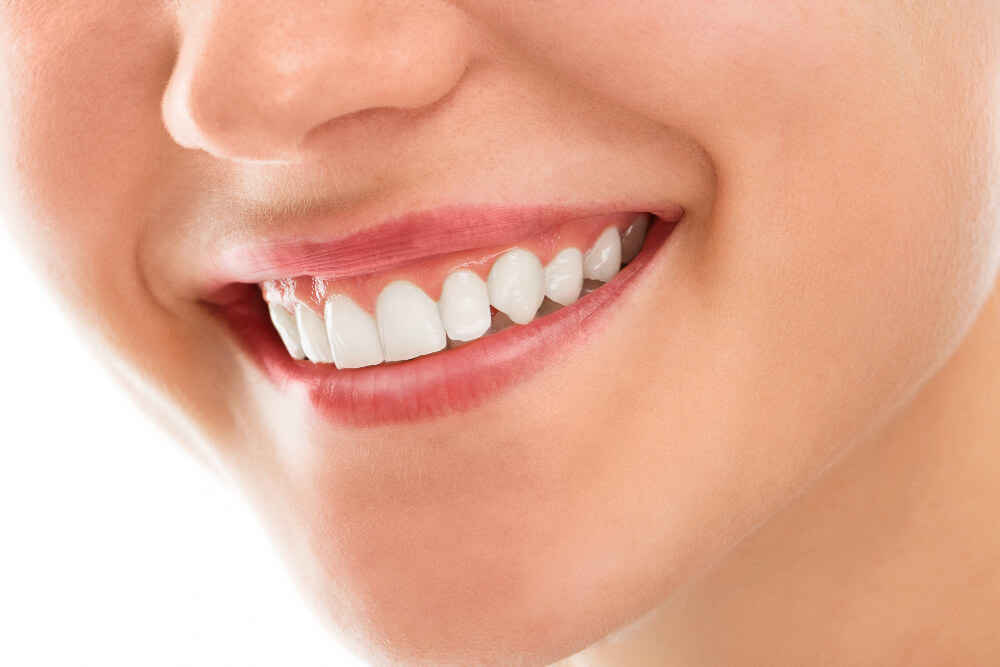
At-home whitening kits can be effective for certain types of stains, but they may not work for all kinds of stains. The effectiveness of the whitening treatment can depend on various factors, including the type and severity of the stains, the concentration of the whitening gel, and the individual’s unique circumstances.
Here’s a breakdown of the different types of stains and how at-home whitening kits may address them:
Extrinsic Stains:
At-home whitening kits are typically successful in eliminating extrinsic stains, which are surface discolorations caused by external factors such as food, beverages (coffee, tea, red wine), tobacco use, and certain pigmented foods. The whitening gel in the kits helps break down and remove these surface stains, resulting in a brighter smile.
Mild to Moderate Intrinsic Stains:
At-home whitening kits can also improve the appearance of mild to moderate intrinsic stains, which are stains that occur within the tooth structure. These stains may result from factors such as aging, trauma, certain medications, or excessive fluoride exposure. While at-home whitening kits may help lighten the overall tooth color and reduce the appearance of these stains, they may not eliminate severe or deeply ingrained intrinsic stains.
Severe Intrinsic Stains:
At-home whitening kits may not be as effective in treating severe intrinsic stains, which can be caused by factors such as certain medications (tetracycline stains) or genetic conditions. In such cases, alternative cosmetic dental procedures like veneers or bonding may be more appropriate for achieving desired results.
Can anyone use At-Home Teeth Whitening Kits?
In general, at-home whitening kits are a viable option for many individuals seeking teeth whitening. However, it is essential to understand that these kits may not be suitable for everyone, and specific factors need to be taken into account.
Consider the following points:
Oral Health:
Good oral health is essential before using any whitening product. It’s recommended to have a dental examination and professional cleaning to address any existing dental issues, such as cavities or gum disease, before starting a whitening treatment.
Age Restrictions:
Some whitening kits may have age restrictions due to the potential sensitivity of developing teeth in children and teenagers. It’s best to consult with a dentist to determine the appropriate age for using a whitening kit.
Tooth Sensitivity:
Individuals with tooth sensitivity may experience discomfort or increased sensitivity during or after using a whitening kit. It’s advisable to consult with a dentist to evaluate the cause of sensitivity and determine if a whitening treatment is suitable or if alternative options should be considered.
Restorations and Dental Work:
At-home whitening kits are generally effective for natural teeth, but they may not whiten dental restorations such as crowns, veneers, or bonding. If you have dental restorations, it’s important to discuss with your dentist whether a whitening treatment is appropriate and how it may affect the color match with your existing restorations.
Compliance and Commitment:
Achieving desired whitening results with At-home kits requires consistent use according to the instructions provided. Individuals must be committed to following the recommended treatment duration and frequency to maximize the effectiveness of the whitening process.
At-Home Teeth Whitening Kits Pros and Cons
At-home whitening kits have their own set of advantages and disadvantages. Here are some pros and cons to consider when using at-home whitening kits:
At-Home Teeth Whitening Kit's - Pros:
- Convenience: At-home whitening kits offer the convenience of whitening your teeth at home, allowing you to incorporate the treatment into your daily routine without the need for frequent dental visits.
- Cost-effective: At-home kits are generally more affordable compared to in-office teeth whitening procedures, making them a cost-effective option for achieving a brighter smile.
- Customizable: The trays provided in at-home kits are custom-made to fit your teeth, ensuring proper application of the whitening gel and maximum contact with the tooth surfaces. This customization helps enhance the effectiveness of the whitening treatment.
- Gradual Whitening: At-home kits provide a gradual whitening process, which can be beneficial for individuals who prefer a more subtle change or have tooth sensitivity concerns. The gradual approach allows for a more controlled and comfortable whitening experience.
- Maintenance and Touch-ups: At-home kits can be used for maintenance and touch-up treatments after in-office whitening or as standalone treatments to maintain the brightness of your smile over time.
At-Home Teeth Whitening Kit's - Cons:
- Longer Treatment Duration: Compared to in-office whitening procedures that yield more immediate results, at-home whitening kits require a longer treatment duration to achieve desired outcomes. It may take several days to weeks of consistent use to see noticeable changes.
- Self-application: Using at-home kits involves self-application of the whitening gel, which may require some skill and attention to ensure even application and avoid potential gum irritation. It’s important to carefully follow the provided instructions and consult your dentist if you have any concerns.
- Limited Strength: At-home kits typically contain lower concentrations of bleaching agents compared to in-office treatments. While this can help minimize tooth sensitivity, it may also result in slightly less dramatic whitening results for certain individuals with stubborn or severe stains.
- Limited Effectiveness on Certain Stains: At-home whitening kits may not be as effective in treating severe intrinsic stains caused by factors like certain medications or genetic conditions. In such cases, alternative cosmetic dental procedures may be required for optimal results
3. Over-the-Counter Teeth Whitening Products
Over-the-counter (OTC) whitening products are readily available teeth whitening options that can be purchased without a prescription from a dentist. These products are commonly found in drugstores, supermarkets, and online retailers.
Here’s some information about over-the-counter whitening products:
Whitening Toothpaste
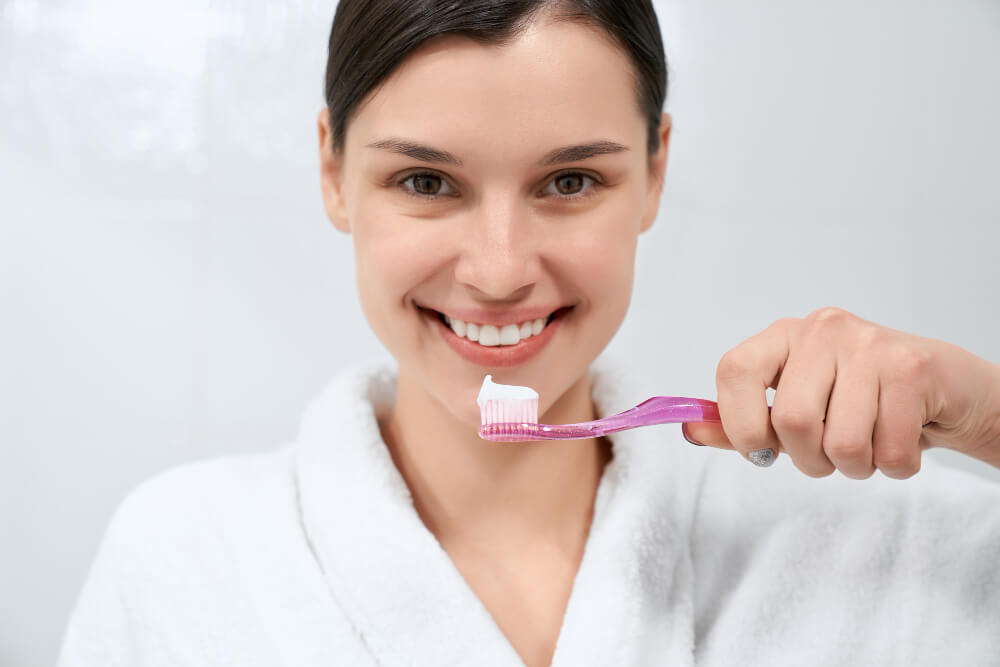
Whitening toothpaste is a popular OTC option for teeth whitening. These toothpaste contain mild abrasives or chemicals that help remove surface stains from the teeth. They are used as part of a regular oral hygiene routine and can provide gradual whitening results over time. However, whitening toothpaste may have limited effectiveness on deeper or more stubborn stains.
Whitening Strips
Whitening strips are thin, flexible strips coated with a bleaching agent, typically hydrogen peroxide or carbamide peroxide. These strips are directly applied to the teeth and left in position for a specified duration, typically ranging from a few minutes to an hour per day. The bleaching agent on the strips helps to lighten surface stains and can provide noticeable whitening results for several days to weeks.
Whitening Gels and Pens
Whitening gels and pens come in a syringe or pen applicator and contain a peroxide-based gel. The gel is applied directly to the teeth using a brush or applicator, targeting specific areas or stains. These products offer convenience and allow for easy touch-ups or spot treatments. However, they may have limited coverage and may not be as effective for overall teeth whitening.
Whitening Rinses
Whitening rinses are mouthwashes that contain a small amount of hydrogen peroxide or other whitening agents. They are swished around the mouth for a specified duration before spitting out. Whitening rinses may provide a subtle whitening effect over time while also freshening breath. However, their contact time with the teeth is usually shorter compared to other whitening products, which can limit their effectiveness.
It’s important to note that over-the-counter whitening products generally have lower concentrations of bleaching agents compared to professional treatments. This can result in more gradual and less dramatic whitening results. Additionally, OTC products may not have custom-fit trays, which can lead to uneven application and increased gum sensitivity if the product comes into contact with the gums.
Over-the-Counter Teeth Whitening Products Pros and Cons
Over-the-counter (OTC) whitening products offer convenience and accessibility for individuals looking to whiten their teeth. However, it’s important to consider the pros and cons before using these products.
Here are some advantages and disadvantages of over-the-counter whitening products:
OTC Teeth Whitening - Pros:
- Affordability: OTC whitening products are generally more affordable compared to professional teeth whitening treatments, making them a cost-effective option for many individuals.
- Convenience: These products are readily available in drugstores, supermarkets, and online retailers, allowing you to purchase and use them at your convenience without the need for dental appointments.
- Ease of Use: OTC whitening products are typically designed for easy self-application. They come with clear instructions that make it simple for individuals to use them at home.
- Gradual Whitening: OTC products often provide a gradual whitening effect over time, which can be desirable for individuals who prefer a more subtle change or have tooth sensitivity concerns.
OTC Teeth Whitening - Cons:
- Limited Strength: OTC whitening products generally have lower concentrations of bleaching agents compared to professional treatments. This can result in slower and less dramatic whitening results, especially for individuals with deeper or more stubborn stains.
- Potential Gum Sensitivity: Improper use or contact of the whitening product with the gums can lead to gum irritation and sensitivity. Custom-fit trays, which are commonly provided in professional treatments, are usually not available with OTC products, increasing the risk of uneven application and potential gum issues.
- Limited Coverage: OTC products may not be as effective in reaching all areas of the teeth, particularly hard-to-reach or overlapping areas. This can result in uneven whitening or noticeable color variations.
- Limited Customization: OTC products have limited customization options for individual needs. They may not address specific concerns such as tooth discoloration due to dental restorations, which require professional assessment and treatment alternatives
- Potential Ineffectiveness for Certain Stains: OTC whitening products may have limited effectiveness on severe intrinsic stains caused by factors like medications or genetic conditions. In such cases, professional treatments or alternative cosmetic dental procedures may be more suitable.
Is Any Side Effects of Over-the-Counter Whitening Products ?
While over-the-counter (OTC) whitening products are generally safe when used as directed, there are some potential side effects to be aware of. It is essential to recognize that individual experiences may differ, and not everyone will encounter these side effects.
Here are a few possible side effects that can be associated with over-the-counter whitening products:
Tooth Sensitivity:
One of the most common side effects of teeth whitening, including OTC products, is tooth sensitivity. The bleaching agents in these products can temporarily increase tooth sensitivity, particularly to hot, cold, or sweet stimuli. This sensitivity is usually mild and subsides after the whitening treatment is complete or discontinued
Gum Irritation:
Improper use or contact of the whitening product with the gums can lead to gum irritation. This can manifest as redness, swelling, or discomfort in the gum tissues. It’s important to follow the instructions provided with the OTC product and avoid excess application or contact with the gums.
Tooth and Gum Sensitivity:
Some individuals may experience temporary sensitivity or discomfort in their teeth and gums during or after using OTC whitening products. This sensitivity is typically short-lived and resolves on its own. However, if the sensitivity persists or becomes severe, it’s advisable to discontinue the treatment and consult a dentist.
Uneven Whitening:
Over-the-counter whitening products, particularly those without custom-fit trays, may lead to uneven whitening results. The product may not fully cover or reach certain areas of the teeth, resulting in uneven coloration or noticeable color variations. This is more likely to occur if the product comes into contact with the gums or is not applied consistently.
Damage to Dental Restorations:
OTC whitening products may not be effective in whitening dental restorations, such as crowns, veneers, or fillings. These restorations are made from materials that do not respond to bleaching agents. As a result, using OTC whitening products may lead to a mismatch in color between natural teeth and dental restorations.
4. Natural Remedies for Teeth whitening
Natural remedies for teeth whitening are alternative approaches that use common household ingredients or natural substances to help brighten the teeth. While these remedies may not provide the same level of effectiveness as professional treatments, they can be used as supplementary methods or for maintaining whiteness after professional whitening.
Here are a few commonly used natural remedies for achieving teeth whitening:
Baking Soda
Baking soda, or sodium bicarbonate, is a commonly used ingredient in DIY teeth whitening. Its mild abrasive properties help remove surface stains from the teeth. You can create a paste by mixing baking soda with water and applying it to your toothbrush. Gently brush your teeth with the paste for a minute or two, then rinse thoroughly.
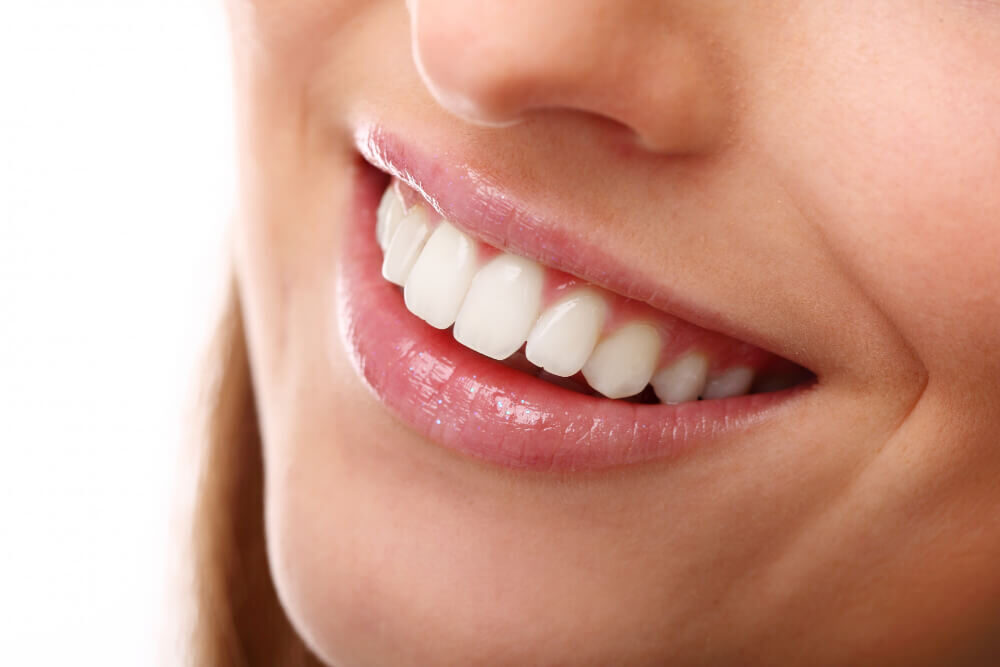
Hydrogen Peroxide
Hydrogen peroxide is a bleaching agent that can help whiten teeth. It is often used in dental products and professional whitening treatments. You have the option to utilize a diluted solution of hydrogen peroxide as a mouthwash or combine it with baking soda to produce a whitening paste. However, it’s important to use hydrogen peroxide in moderation and avoid swallowing it.
Oil Pulling
Oil pulling is an ancient Ayurvedic practice that involves swishing oil in the mouth to remove toxins and promote oral health. Some people claim that oil pulling with coconut oil or sesame oil can also help whiten teeth. Swish a tablespoon of oil in your mouth for about 10-15 minutes, then spit it out and rinse thoroughly.
Apple Cider Vinegar
Apple cider vinegar has natural whitening properties and can be used as a mouthwash. However, it’s important to use it with caution as it is acidic and can erode tooth enamel. Dilute apple cider vinegar with water and swish it around in your mouth for a few seconds, then rinse thoroughly.
Strawberries
Strawberries contain malic acid, which can help remove surface stains from the teeth. You can mash a ripe strawberry and apply it directly to your teeth, or mix it with baking soda to create a natural whitening paste. However, be mindful of the natural sugars present in strawberries and rinse your mouth thoroughly afterward.
Natural Remedies Pros and Cons
Natural remedies for teeth whitening have their own set of pros and cons. Here are some of the advantages and disadvantages:
Natural Remedies - Pros:
- Accessibility: Natural remedies for teeth whitening often use common household ingredients that are easily accessible. These ingredients can be found in most kitchens or purchased at a low cost from grocery stores.
- Accessibility: Natural remedies for teeth whitening often use common household ingredients that are easily accessible. These ingredients can be found in most kitchens or purchased at a low cost from grocery stores.
- Affordability: Compared to professional teeth whitening treatments, natural remedies are typically more affordable. This makes them a cost-effective option for individuals who are looking for more budget-friendly alternatives.
- Ease of Use: Natural remedies are generally easy to use and require minimal preparation. Most remedies involve simple mixtures or applications that can be done at home with basic tools.
- Gentle Approach: Natural remedies tend to have a milder impact on the teeth compared to professional treatments. They are generally less abrasive and may be better suited for individuals with sensitive teeth or gums.
Natural Remedies - Cons:
- Limited Effectiveness: While natural remedies can help remove some surface stains and brighten the teeth to some extent, they may not provide the same level of effectiveness as professional treatments. Stubborn or deep stains may require stronger bleaching agents available in professional settings.
- Gradual Results: Natural remedies usually produce gradual results, meaning it may take repeated applications over time to see noticeable changes in tooth color. If you’re looking for more immediate and dramatic results, professional treatments may be a better option.
- Potential Side Effects: Certain natural remedies, including baking soda, lemon juice, or apple cider vinegar, have the potential to be abrasive or acidic. Excessive or improper use of these ingredients can result in enamel erosion, tooth sensitivity, or gum irritation. It is crucial to exercise caution and moderation when utilizing them.
- Lack of Customization: Natural remedies cannot be customized to individual needs or address specific dental concerns. They may not be effective for certain types of stains or discoloration, such as those caused by medications or intrinsic factors. Professional treatments offer a more tailored approach based on individual circumstances.
- Safety Concerns: While natural remedies are generally safe when used properly, there is a risk of misuse or improper application. It’s important to follow instructions carefully and consult with a dentist if you have any concerns or underlying dental conditions.
Do's and Don't After Teeth Whitening
To achieve optimal results and preserve the whiteness of your teeth after undergoing teeth whitening, it is essential to adhere to specific guidelines.
Consider the following do’s and don’ts:
Do's
- Follow post-treatment instructions: Your dentist or teeth whitening professional will provide specific instructions for aftercare. It’s important to follow these instructions carefully to optimize the results and avoid any complications.
- Eat white-friendly foods: For the first 48-72 hours after teeth whitening, it’s recommended to consume foods and beverages that are less likely to stain your teeth. Stick to a white-friendly diet that includes white meats, plain yogurt, white rice, and clear beverages like water or milk.
- Stay hydrated: Drink plenty of water to keep your mouth hydrated and to help flush away any potential staining substances.
- Schedule regular dental cleanings: Maintain regular dental check-ups and cleanings to keep your teeth and gums healthy. Professional cleanings can help remove surface stains and maintain the brightness of your teeth.
Don't
- Consume staining substances: Avoid consuming foods and beverages that are known to stain teeth, especially in the first 48-72 hours after whitening. This includes coffee, tea, red wine, dark sodas, berries, tomato sauce, and soy sauce.
- Smoke or use tobacco products: Smoking or using tobacco products can lead to tooth discoloration. It’s best to avoid these habits altogether to maintain the results of your teeth whitening treatment.
- Use colored mouthwashes or staining oral products: Some mouthwashes and oral products contain dyes or coloring agents that can potentially stain your teeth. Opt for clear or whitening mouthwashes and consult with your dentist for recommendations.
- Overwhelm your teeth with whitening products: While it may be tempting to continue using at-home whitening products immediately after professional whitening, it’s important to give your teeth a break. Overuse of whitening products can lead to tooth sensitivity and potential damage to the enamel.
- Neglect oral hygiene: Maintain consistent oral hygiene practices to keep your teeth and gums healthy. Skipping brushing or flossing can allow plaque and stains to accumulate on your teeth.
Conclusion
In conclusion, teeth whitening is a popular cosmetic procedure aimed at brightening and enhancing the appearance of teeth. There are various methods available, including in-office teeth whitening, take-home whitening kits, and over-the-counter whitening products. Every approach possesses distinct advantages and disadvantages.
In-office teeth whitening performed by dental professionals offers the advantage of immediate and significant results. The procedure involves the application of a bleaching agent and may require multiple sessions. While it can effectively remove a wide range of stains, it may be more costly compared to other options.
At-home whitening kits provide convenience and flexibility, allowing individuals to whiten their teeth in the comfort of their own homes. These kits typically include custom-fitted trays and a whitening gel, which gradually lightens the teeth over several weeks of consistent use. While they may not provide as dramatic results as in-office treatments, they are generally more affordable and can still yield noticeable improvements.
Over-the-counter whitening products, such as whitening toothpaste, strips, or pens, offer convenience and accessibility. They are readily available for purchase without requiring a prescription. However, their effectiveness may vary, and they may not be as potent as professional treatments. It’s important to follow the instructions carefully and be aware of any potential side effects.
Natural remedies for teeth whitening can be used as supplementary methods or for maintaining whiteness after professional treatments. Ingredients like baking soda, hydrogen peroxide, oil pulling, apple cider vinegar, and strawberries are commonly used. While they may offer some benefits, they are generally milder and may have limited effectiveness compared to professional treatments.
In general, the selection of a teeth whitening method relies on individual preferences, budget considerations, and the extent of discoloration present. It’s essential to consult with a dentist to determine the most suitable approach based on your specific needs and to ensure the safety and effectiveness of the chosen method. Remember to follow post-treatment guidelines and maintain good oral hygiene to maximize and prolong the results of teeth whitening.
Resources
Image Designed by freepik
References
https://www.forbes.com/health/body/professional-teeth-whitening-guide/
https://www.ncbi.nlm.nih.gov/pmc/articles/PMC6784469/
https://www.ncbi.nlm.nih.gov/pmc/articles/PMC4058574/
https://www.mdpi.com/1422-0067/24/3/1956
https://www.frontiersin.org/articles/10.3389/fdmed.2021.687507/full
https://www.ada.org/resources/research/science-and-research-institute/oral-health-topics/whitening



